Ocean vertical velocities and biogeochemical coupling
Ocean vertical velocities are a key factor in understanding ocean dynamics and its impact on biogeochemistry. Their order of magnitude is much smaller than that of horizontal velocities, making them particularly difficult to measure in situ. To meet this challenge, the team is proposing innovative instrumental and methodological developments. The deployment of these instruments will enable us to study vertical velocities and their impact on biogeochemical processes, such as the carbon pump and the upwelling of nutrients.
In particular, the team is interested in fine oceanic scales (from 1 to 100 km with a lifetime of a few days to a few months) that may involve agéostrophic and three-dimensional dynamics, generally associated with the presence of vertical velocities. These fine scales play a fundamental role in the physical and biogeochemical balance of the ocean.
Recent publications
Nitrogen fixation in the North Atlantic supported by Gulf Stream eddy-borne diazotrophsNature ..., 2024 - nature.com.
A "natural sand plant" at the shelf edge in the low-energy Gulf of Lions, western Mediterranean SeaS Berné, G Agin, Y Alonso, MA Bassetti, F Bourrin, B Hébert, C Estournel, ..., Geology, 2024.
Rapid restratification processes control mixed layer turbulence and phytoplankton growth in a deep convection regionM Miracca-Lage, J Becherer, L Merckelbach, A Bosse, P Testor, ..., Geophysical Research Letters 51 (10), e2023GL107336, 2024.
A synthesis of ocean total alkalinity and dissolved inorganic carbon measurements from 1993 to 2022: the SNAPO-CO2-v1 datasetN Metzl, J Fin, C Lo Monaco, C Mignon, S Alliouane, D Antoine, ..., Earth System Science Data 16 (1), 89-120.
Phytoplankton reaction to an intense storm in the north-western Mediterranean Sea..., S Barrillon, R Fuchs, AA Petrenko, C Comby... - ..., 2023 - bg.copernicus.org.
The contrasted phytoplankton dynamics across a frontal system in the southwestern Mediterranean Sea..., R Tzortzis, AM Doglioli, M Messié, S Barrillon... - ..., 2023 - bg.copernicus.org
Near Inertial Oscillations and Vertical Velocities Modulating Phytoplankton After a Storm in the Mediterranean Sea..., C Ulses, A Bosse, A Doglioli, S Barrillon - Journal of Water ..., 2023 - amu.hal.science.
Diazotroph connectomics in Gulf Stream eddies supports N2 fixation in the North Atlantic2023 - researchsquare.com.
Basin-scale biogeochemical and ecological impacts of islands in the tropical Pacific Ocean, M Messié, A Petrenko, AM Doglioli, E Martinez, S Alvain, Nature Geoscience 15 (6), 469-474, 15, 2022.
The heatwave of summer 2022 in the North-Western Mediterranean Sea: Some species were winners..., M Perret-Boudouresque, S Ruitton, I Taupier-Letage... - Water, 2024 - mdpi.com
Assessing seasonal and interannual changes in carbonate chemistry across two time-series sites in the North Western Mediterranean SeaFrontiers in Marine Science 10, 1281003.
Biological applications of the satellite Surface Water and Ocean Topography in the Mediterranean..., F Carlotti, M Lescot, B Aude, S Barrillon,A. Petrenko... - 2024 - hal.science.
BioSWOT Med. Biological applications of the satellite Surface Water and Ocean Topography in the Mediterranean..., E Pulido, F Carlotti, M Lescot, A Barani, S Barrillon, A. Petrenko... - 2024 - archimer.ifremer.fr.
A Software Package for an Adaptive Satellite-based Sampling for Oceanographic cruises (SPASSOv2. 0): tracking fine scale features for physical and biogeochemical ..., ..., L Izard, A Della Penna, A Petrenko, S Barrillon... - 2024 - hal.science.
Estimating ocean vertical velocities using an autonomous multipurpose profiler, JL Fuda, S Barrillon, C Comby, A. Petrenko... - ... on Metrology for the ..., 2023 - ieeexplore.ieee.org.
Measuring vertical velocities with ADCPs in low-energy ocean... of Atmospheric and ..., 2022 - journals.ametsoc.org.
Projects in progress
HOPE-VV HOw Physical processes affect ocean CO2 capturE : focus on Vertical Velocities - PI A. Petrenko, AMIDEX project. Study of the intensity of VVs and their temporal variability at high frequency (hour) by deploying a set of 5 physical moorings (including a 5-beam Acoustic Doppler Current Profiler -ADCP-); of the spatial variability of VVs across physical structures (e.g. eddy cores, fronts, filaments, etc.) by carrying out free-fall 5-beam ADCP profiles (to obtain the best possible measurement of VVs).) by performing 5-beam ADCP profiles in the free crust (to get the best possible VV measurement) and by deploying the new upgraded VVProfiler with programming that can target selected layers (mixing layer boundary, DCM...) during seasonal ocean expeditions around selected contrasting environments (off New Caledonia).
CNES TOSCA 2023-2026 project, GLISS Using gliders to expand SWOT satellite currents measurements, 22k€ (A. Bosse, A. Petrenko). The project proposes to help collect measurements by underwater gliders during the SWOT satellite Calibration/Validation phase in order to study the geostrophic currents signal under the satellite swath repeated daily from April 2023 to July 2023. The project has two study regions: the north-western Mediterranean and the Nordic Seas, where two long-term observation systems regularly deploy gliders (MOOSE and NorEMSO respectively).
CNRS LEFE-IMAGO 2023-2025 project, DISTURB-SWOT DISentangling TURBulence and fine-scale processes: a combined in situ/satellite approach during SWOT CalVal period, 36.5k€ (A. Bosse, A. Petrenko, S. Barrillon). The aim of this project is to carry out microstructure turbulence measurements by underwater glider during the BioSWOT-Med campaign in April 2023 in order to study the large-scale cascade towards turbulent kinetic energy dissipation in the context of the new SWOT satellite measurements and during a campaign focusing on the coupling between physics and biogeochemistry and biology.
MOOSE National Observation Service accredited by the CNRS-INSU since 2010, MIO budget 60k€/year (A. Bosse, A. Petrenko, C.A. Guerin, B. Zakardjian). This observatory system carries out long-term monitoring of the physical, biogeochemical and biological systems of the north-western Mediterranean. MIO and OSU Pytheas are in charge of several SNO MOOSE sites: repeated glider radial T02 (Marseille-Minorque), MOOSE-GE large-scale annual campaign and monthly CTD station at the ANTARES site, atmospheric deposition collection at Frioul, HF radars at Toulon and Nice, JULIO mooring at the entrance to the bay of Marseille).




